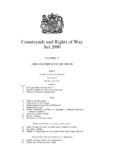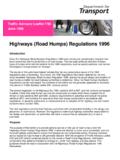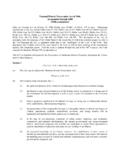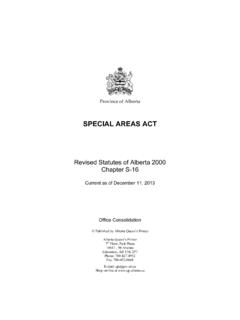Transcription of Parking: pavement and on-street
1 parking : pavement and on-street Standard Note: SN/BT/1170 Last updated: 12 July 2010 Author: Louise Butcher Section Business and Transport This Note outlines the general legal position on pavement parking and the measures available to the police and local authorities to tackle it. There is no national prohibition against on-street or pavement parking except in relation to heavy commercial vehicles. Local authorities may act to tackle pavement parking in various ways, such as under legislation governing obstruction and dangerous parking ; designating limited areas of no pavement parking through a Traffic Regulation Order (TRO); or establishing a special parking area.
2 However, this is a difficult area and there has always has been a problem of enforcement of such legal remedies as do exist. Information on other parking -related matters can be found on the Roads Topical Page of the Parliament website. Contents 1 Local authority powers 2 Obstruction 2 Traffic Regulation Orders (TROs) 3 parking restrictions 4 2 Clean Neighbourhoods and Environment Act 2005 4 3 Previous efforts to legislate 4 This information is provided to Members of Parliament in support of their parliamentary duties and is not intended to address the specific circumstances of any particular individual. It should not be relied upon as being up to date; the law or policies may have changed since it was last updated; and it should not be relied upon as legal or professional advice or as a substitute for it.
3 A suitably qualified professional should be consulted if specific advice or information is required. This information is provided subject to our general terms and conditions which are available online or may be provided on request in hard copy. Authors are available to discuss the content of this briefing with Members and their staff, but not with the general public. 1 Local authority powers There is no national prohibition against on-street or pavement parking except in relation to heavy commercial vehicles. These vehicles, defined as goods vehicles with an operating weight exceeding tonnes, are prohibited from parking on verges, footpaths or the central reservations of roads under section 19 of the Road Traffic Act 1988.
4 parking in breach of section 19 is a fixed penalty offence, although the section allows specific exceptions to the general prohibition including loading and unloading in specified circumstances and parking in an emergency to save life. Some pavement parking will be seen as causing an obstruction and can be dealt with by the police or traffic wardens. However, in many areas local authorities have assumed control for decriminalised/civil parking enforcement under the Road Traffic Act 1991 and the Traffic Management Act As part of this process they can designate Special parking Areas (SPAs) in which vehicles parked on street or on the pavement can be ticketed for contravening parking regulations ( parking on a yellow line), rather than for causing an obstruction.
5 Some local authorities, for example Worcester, Exeter and Hereford, took their own Private Act powers to ban pavement parking within their areas. Government guidance is available for all local authorities on alternative, non-legislative measures to discourage pavement parking . This includes suggestions such as guardrails, the planting of trees and the placement of bollards on pavements. Such physical measures, whilst perhaps costly in the first instance, have the advantage of being self-policing and Obstruction Local authorities and the police have the power to remove a vehicle if it is illegally parked, causing an obstruction or has been abandoned. The power to remove vehicles is given to the police by sections 99-102 of the Road Traffic Regulation Act 1984, as amended, and by the Removal and Disposal of Vehicles Regulations 1986 (SI 1986/183), as amended, made under sections 99 and 101 of the 1984 Act.
6 The powers of removal under section 99 include vehicles which are parked illegally, have broken down and those which cause obstruction, danger or potential danger. If therefore it can be shown that a vehicle is illegally parked, causing an obstruction or is abandoned, the local authority and the police may remove it under this legislation. It should be pointed out, however, that they do not have to remove a vehicle in any of these three cases, merely that they may do so. A vehicle can only be illegally parked if there are parking restrictions operating in the area. In other cases one would have to show a vehicle was causing an obstruction. The police can remove vehicles which are causing an obstruction and there are a number of statutes and regulations which allow proceedings to be brought for obstructing the highway.
7 These include: Highways Act 1980, section 137 (wilfully obstructing the free passage of a highway); Town Police Clauses Act 1847, section 28 (wilfully causing an obstruction in any public footpath or public thoroughfare); and 1 the TMA repealed most of the parking provisions of the 1991 Act 2 DfT, pavement parking (Traffic Advisory Leaflet TAL 04/93), 1993 2 Road Vehicles (Construction and Use) Regulations 1986 (SI 1986/1078), regulation 103 (causing or permitting a motor vehicle or trailer to stand on a road so as to cause any unnecessary obstruction of the road). There is a good deal of case law on the general issue of obstruction . The meaning of unnecessary obstruction is discussed in Sweet & Maxwell s Encyclopaedia of Road Traffic Law and Practice: It appears that for an obstruction to be "unnecessary", there must be an unreasonable user of the road; and the question whether a user is unreasonable involves consideration of all the circumstances, including the length of time the obstruction continues, the place where it occurs, the purpose for which it is done and whether it does in fact cause an actual as opposed to a potential obstruction: Evans v.
8 Barker [1971] 453; Nelmes v. Rhys Howells Transport Ltd. [1977] 266. A vehicle left on a road for an unreasonable time may constitute an unnecessary obstruction: Solomon v. Durbridge (1956) 120 231 (car parked for five hours on Victoria Embankment). But if the vehicle is left only for a reasonable time, then even if it amounts to an obstruction the defendant is not to be convicted of an offence under this regulation: Evans v. Barker, supra (car parked in Oswestry on market day between and , 20 foot width of road left clear). Compare Worth v. Brooks [1959] 855, where the question was left open whether reasonable parking could be an unnecessary obstruction.
9 Where a large vehicle was parked between and in a cul-de-sac outside the defendant's home, the defendant's appeal was allowed because there was no evidence of any unreasonable user of the road: Police v. O'Connor [1957] 478. Similarly, where a car was parked in a bus bay for five minutes but no bus was actually obstructed, it was held that there was no evidence to justify a conviction under this regulation: Brown v. Cardle, 1983 218; 1982 495. But where a taxi brought traffic to a halt in a busy street for nearly a minute while attempting a U-turn, it was held that there was ample evidence upon which an obstruction could be found and the conviction stood despite the defendant's plea that his conduct had not been unreasonable: Wall v.
10 Williams [1966] 50. (..) With this regulation, compare of the Town Police Clauses Act, 1847 (so far as it concerns wilfully causing an obstruction in a public thoroughfare) and of the Highways Act, 1980 (wilfully obstructing the free passage along a highway). Under both sections it has been held that to constitute an offence there must be proof of an unreasonable user of the highway: Gill v. Canon and Nield [1917] 2 674. Nagy v. Weston [1965] 1 280; [1965] 1 All 78. In many areas the police will use section 137 of the Highways Act 1980. If a householder's passage along the highway is impeded by a parked car and he cannot get on or off the highway because a car is parked in or in front of his drive, many police forces will consider there is an obstruction and will ticket the car or possibly ticket and remove it.





